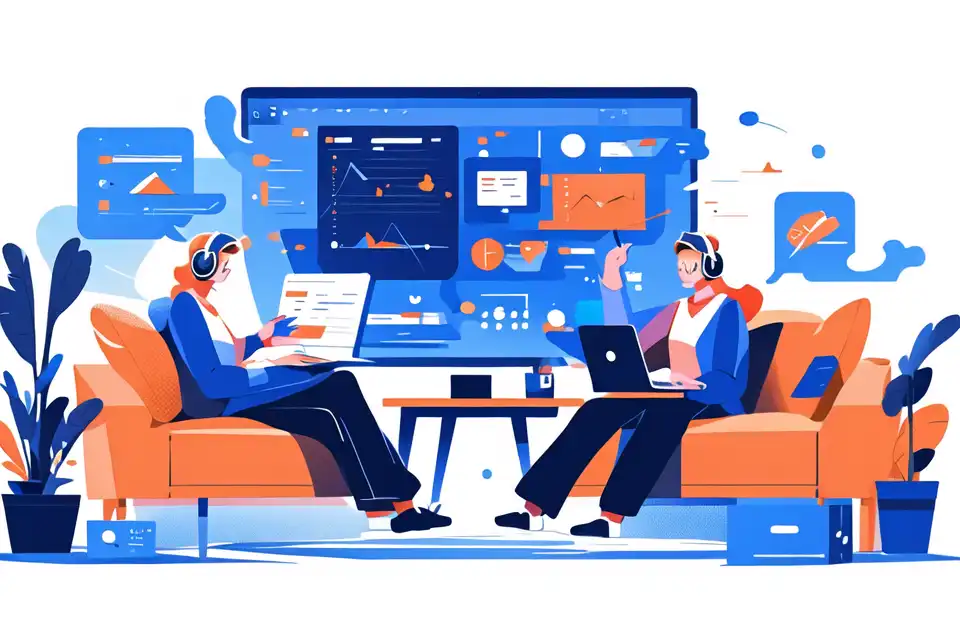Procedural Animation
Unlock the potential of Procedural animation with the comprehensive Lark glossary guide. Explore essential terms and concepts to excel in the gaming realm with Lark solutions.
Try Lark for Free
Procedural animation is a technique used in the gaming industry to generate realistic and dynamic animations in real-time. Unlike traditional animation, where each movement is manually created and stored as a sequence of frames, procedural animation uses algorithms and rules to generate animations on the fly. This approach allows for greater flexibility and variety in character movements, making the gaming experience more immersive and engaging.
Leverage the full capabilities of Lark Base to streamline, oversee, and successfully execute your real estate strategies and initiatives.
Define procedural animation and its relevance in the gaming industry
Procedural animation involves using mathematical algorithms and rules to generate animations in real-time. It is a dynamic and adaptive method that allows for the creation of lifelike movements in characters and objects. This technique is especially relevant in the gaming industry, where realistic and fluid animations are crucial for creating immersive game worlds.
For gamers, procedural animation enhances the visual experience by providing more natural and responsive movements. It adds a layer of realism to characters and objects, making them feel more alive and believable. This can greatly enhance the overall immersion and enjoyment of playing a game.
From a business perspective, understanding and implementing procedural animation can give gaming companies a competitive edge. By creating more realistic and dynamic animations, games can stand out in a saturated market and attract more players. Procedural animation also offers cost-saving benefits, as it requires less manual labor compared to traditional animation methods.
Significance of procedural animation in gaming
Procedural animation plays a crucial role in gaming, and its significance cannot be overstated. Firstly, it allows for more diverse and complex character movements. With procedural animation, developers can create lifelike walking, running, and other actions that adapt to different environments and situations. This level of realism enhances the player's immersion and makes the game world feel more alive.
Secondly, procedural animation enables procedural content generation. This means that game environments, such as landscapes, buildings, and vegetation, can be generated dynamically based on algorithms. This saves time and resources for developers and allows for infinite possibilities in game design.
Thirdly, procedural animation provides a more interactive and responsive gaming experience. For example, in combat games, characters can have procedural animations that respond to the player's actions, making the combat feel more dynamic and engaging.
Overall, understanding and utilizing procedural animation can greatly enhance the quality and appeal of games, ultimately leading to more satisfied players and increased revenue for gaming businesses.
Who benefits from procedural animation in gaming
Procedural animation benefits various stakeholders in the gaming ecosystem.
-
Gamers: Players benefit from procedural animation by experiencing more realistic and immersive gameplay. The lifelike movements of characters and objects enhance the overall gaming experience and make the game world more believable.
-
Game Developers: Procedural animation provides game developers with a powerful tool for creating dynamic and realistic animations. It saves time and resources by automating the animation process and allows for more creative freedom in game design.
-
Gaming Businesses: Procedural animation can give gaming businesses a competitive edge in the market. Games with high-quality animations are more likely to attract players and generate revenue. Additionally, the cost-saving benefits of procedural animation can contribute to a more efficient and profitable business model.
-
Artists and Animators: Procedural animation offers new opportunities for artists and animators to explore and expand their skills. It allows them to create complex and realistic animations without the need for manual frame-by-frame animation. This can lead to more innovative and visually stunning game designs.
Overall, the adoption of procedural animation benefits all stakeholders in the gaming industry, leading to improved gameplay experiences, increased player engagement, and business success.
Related:
Overcast Games Software Development Service Chooses Lark to Power Effective Team CollaborationLearn more about Lark x Gaming Industry
How procedural animation works for gaming businesses
Practical Implications and Why It Matters
Procedural animation works by using mathematical algorithms and rules to generate animations in real-time. Instead of relying on pre-defined animations, the movements of characters and objects are computed on the fly, based on the game's logic and physics.
For gaming businesses, understanding and implementing procedural animation can have several practical implications.
-
Enhanced Player Experience: Procedural animation allows for more realistic and dynamic movements in games. This enhances the player experience by making characters and objects feel more alive and responsive. Players are more likely to be engaged and immersed in a game that offers high-quality animations.
-
Cost Savings: Traditional animation methods require a significant amount of manual labor to create and store animations frame by frame. In contrast, procedural animation automates the animation process, reducing the need for extensive manual work. This can result in cost savings for gaming businesses, as fewer resources are required to create animations.
-
Flexibility and Adaptability: Procedural animation offers greater flexibility and adaptability compared to pre-defined animations. Developers can easily modify and adjust animations based on the game's requirements, without the need to create new animations from scratch. This allows for more iterative and efficient game development processes.
-
Infinite Variation: Procedural animation enables the generation of animations with infinite variation. This means that each playthrough of a game can offer unique animations and experiences, making the gameplay more engaging and replayable. This infinite variation can also contribute to the longevity of a game's lifespan in the market.
Implementing procedural animation effectively requires a deep understanding of the underlying algorithms and techniques. By investing in research and development, gaming businesses can leverage procedural animation to create visually impressive and immersive games, ultimately leading to increased player satisfaction and business success.
Best Practices when Considering Procedural Animation in Gaming and Why It Matters
When considering procedural animation in gaming, there are several best practices and strategies that can help ensure its effective implementation.
-
Invest in Research and Development: Procedural animation is a complex field that requires expertise and continuous learning. Gaming businesses should invest in research and development to stay updated with the latest advancements and techniques. This will enable them to leverage procedural animation effectively and push the boundaries of what is possible in game design.
-
Collaboration between Artists and Programmers: Procedural animation requires collaboration between artists and programmers. Artists provide the creative vision and input, while programmers implement the algorithms and rules to generate the animations. Effective communication and collaboration between these two disciplines are essential to create high-quality procedural animations.
-
Test and Iterate: Procedural animation can be a trial-and-error process. It is important to test and iterate on the animations to ensure they meet the desired quality and realism. This may involve tweaking parameters, adjusting algorithms, or seeking feedback from players. Continuous improvement and refinement are key to achieving optimal procedural animations.
-
Balance Procedural and Handcrafted Animations: While procedural animation offers many benefits, it is important to strike a balance between procedural and handcrafted animations. Certain animations may require a more precise and controlled approach that can be achieved through traditional animation methods. Combining both procedural and handcrafted animations can result in a visually stunning and dynamic game world.
By following these best practices, gaming businesses can harness the power of procedural animation and create games that captivate players and stand out in the competitive gaming market.
Actionable tips for leveraging procedural animation in the gaming industry
Tip 1: Embrace the Power of Procedural Animation
Procedural animation offers a wide range of possibilities in game design. Embrace its power and explore creative ways to use it in your games. From character movements to environmental changes, leverage procedural animation to create dynamic and immersive gameplay experiences.
Tip 2: Invest in Research and Development
Stay up to date with the latest advancements in procedural animation by investing in research and development. This will ensure that you have a deep understanding of the techniques and algorithms involved, allowing you to push the boundaries of what is possible in game animation.
Tip 3: Collaborate between Artists and Programmers
Encourage collaboration between artists and programmers to make the most of procedural animation. Artists can provide the creative vision and input, while programmers can implement the algorithms and rules. Effective collaboration will result in high-quality procedural animations that enhance the overall gaming experience.
Related:
Overcast Games Software Development Service Chooses Lark to Power Effective Team CollaborationLearn more about Lark x Gaming Industry
Related terms and concepts to procedural animation in the gaming industry
Related Term or Concept 1: Procedural Content Generation
Procedural content generation is the process of using algorithms to generate game content, such as landscapes, buildings, and items, dynamically. This allows for infinite possibilities in game design and can greatly enhance the replayability and variety of a game.
Related Term or Concept 2: Real-time Animation
Real-time animation refers to animations that are generated and rendered in real-time as the game is being played. This allows for immediate response to player input and creates a more interactive and dynamic gaming experience.
Related Term or Concept 3: Physics-based Animation
Physics-based animation involves using real-world physics principles and algorithms to simulate realistic movements and interactions in a game. This can include the simulation of gravity, collision detection, and object dynamics, resulting in more lifelike animations.
Conclusion
In conclusion, procedural animation is a powerful technique that plays a significant role in the gaming industry. Its ability to generate realistic and dynamic animations in real-time enhances the player experience, attracts more players to games, and provides cost-saving benefits for gaming businesses. By understanding and implementing procedural animation effectively, gaming companies can create visually impressive and immersive games that stand out in the market. Continuous learning and adaptation to the dynamic gaming landscape are key to leveraging the full potential of procedural animation.
Learn more about Lark x Gaming Industry
Leverage the full capabilities of Lark Base to streamline, oversee, and successfully execute your real estate strategies and initiatives.








